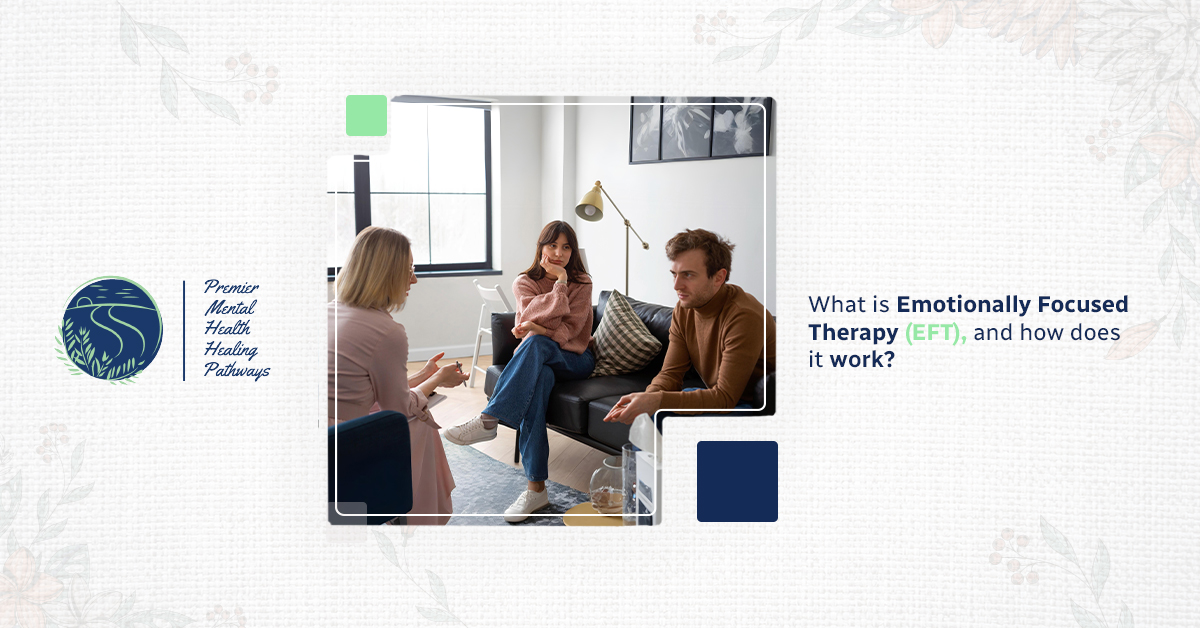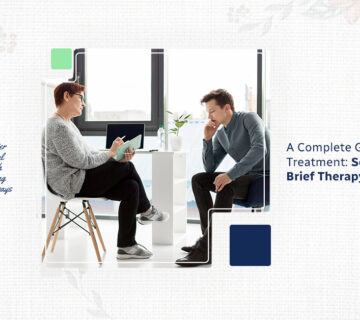An Introduction to Emotionally Focused Therapy
Emotionally Focused Therapy (EFT) is a scientifically supported method of therapy that deals with the deep emotional patterns that cause problems in relationships. This evidence-based intervention concentrates on emotional processing and interpersonal attachment bonds, providing structured avenues for improved relational connectivity and individual emotional regulation.
EFT was created as a methodical way to help people with emotional and relationship problems. It works very well for couples, families, and individuals. This all-encompassing guide looks at the theoretical bases, real-world uses, and clinical results of Emotionally Focused Therapy.
This article offers crucial insights into the methodology, efficacy, and suitable applications of EFT in modern mental health practice for mental health professionals, clients pursuing therapeutic services, and individuals investigating evidence-based treatment modalities.
Understanding the Theoretical Basis of EFT
What is Emotionally Focused Therapy?
Emotionally Focused Therapy is a structured, short-term therapeutic intervention based on attachment theory and humanistic principles. This method includes three main types: EFT for Couples (EFT-C), EFT for Families (EFFT), and EFT for Individuals (EFIT).
The therapeutic framework underscores emotional accessibility, responsiveness, and engagement as fundamental elements of healthy attachment relationships. EFT interventions focus on changing unhealthy ways of interacting with others while also building secure attachment bonds through systematic emotional processing and behavioral restructuring.
EFT has some important features, such as
- Approach based on feelings: Puts emotional awareness and expression first
Attachment-based framework: Integrates the principles of Bowlby’s attachment theory. - Methodology based on evidence: Backed by a lot of research showing that it works in the clinic
- Systematic structure: Follows well-defined steps and actions
Growth and Change Over Time
In the 1980s, Dr. Sue Johnson was the first to use Emotionally Focused Therapy, which is based on humanistic therapy and family systems theory. Leslie Greenberg made a big difference in the emotion-focused therapeutic approaches that helped EFT grow.
The therapeutic model has been improved and expanded over time, and it is now widely used around the world and recognized by the American Psychological Association. Modern EFT practice integrates advancements in neuroscience, attachment theory, and trauma-informed care principles.
Research validation has confirmed EFT as a leading evidence-based intervention for relationship distress, with ongoing studies endorsing its use across various populations and addressing pertinent issues.
Fundamental Theoretical Tenets of EFT
Main Theoretical Parts
Emotionally Focused Therapy is based on a number of basic ideas that set it apart from other types of therapy:
- Emotional Primacy: Emotions function as adaptive information systems that indicate fundamental needs and motivations rather than merely problematic symptoms necessitating eradication.
- Attachment Security: Secure attachment relationships are vital for psychological health, emotional regulation, and effective interpersonal functioning.
- Cycle Identification: Negative interaction patterns keep relationship problems going by causing people to react emotionally and behave in the same way over and over again.
- Systematic Intervention: Therapeutic transformation transpires through the de-escalation of detrimental patterns, succeeded by a reconfiguration towards constructive interaction cycles.
These principles guide clinical interventions aimed at augmenting emotional processing, enhancing attachment security, and fostering enduring behavioral modifications within relational frameworks.
The Three-Stage EFT Treatment Model
Step One: Stop the escalation and find the cycle.
The first step in treatment is to find and map out negative interaction patterns that keep relationships from getting better. Therapists help clients become aware of what makes them feel certain things, how they react to those feelings, and what their attachment needs are.
At this point, clinical interventions include:
- Evaluation of presenting issues and relational history
- Recognizing negative patterns of interaction
- Tracking emotions and growing awareness
- De-escalation of immediate conflict dynamics
- Clients learn how their own emotional reactions affect their relationships, which helps them stop blaming others and feeling defensive.
Step Two: Restructuring and Getting Emotionally Involved
During the restructuring phase, the focus is on accessing and expressing primary emotions while also making new experiences with other people. Clients learn how to talk about their attachment needs and how to respond with empathy to their partner’s feelings.
Some therapeutic techniques are:
- Enactments: Organized interactions that encourage people to show their feelings
- Building empathy: exercises that make you more emotionally responsive
- Vulnerability practice: sharing your main feelings with someone else
- Creating a positive cycle: Learning how to form secure attachments
This stage causes big changes in how emotionally open and responsive relationship partners are to each other.
Step Three: Putting things together and making them work together
The last phase of treatment builds on the progress made in therapy while also helping people learn how to solve problems and talk to each other in a way that will last. Clients incorporate novel emotional and behavioral patterns into their daily relational functioning.
Integration activities include:
- Strengthening cycles of positive interaction
- Creating ways to solve conflicts
- Planning to avoid relapses
- Keeping up emotional connection skills
- Clinical Procedures and Interventions
The main EFT interventions
EFT therapists use certain methods to help people process their emotions and feel safe in their attachments.
- Reflective Listening: Therapists give clients accurate, empathetic responses that validate their feelings and help them become more aware of themselves.
- Tracking: Watching and commenting on how people interact with each other in real time helps clients understand how cycles work as they happen.
- Heightening: Making emotional experiences stronger makes clients more aware of their primary emotions and the attachment needs that lie beneath them.
- Reframing: Changing the way you think about relationship problems from blame-focused stories to attachment-based stories.
These interventions uphold a collaborative, non-pathologizing therapeutic approach that fosters client empowerment and the restoration of relationships.
Evidence-Based Advantages of EFT
Results from clinical studies and research
A lot of research shows that EFT works well on a number of different outcome measures:
70–75% of couples see a big improvement in their relationship satisfaction.
- Treatment maintenance: Therapeutic benefits persist during subsequent evaluations.
- Individual symptoms: Lessening of anxiety and depression symptoms
- Family functioning: Improved communication and emotional bonding.
- Meta-analytic studies consistently validate EFT as a highly effective intervention for relationship distress, demonstrating effect sizes that are comparable to or surpass those of alternative couple therapy modalities.
Long-Term Therapeutic Advantages
EFT leads to lasting improvements in how people manage their emotions, communicate, and feel satisfied with their relationships. Clients report ongoing improvement after finishing treatment, which shows that they have learned skills that will last and formed secure attachment patterns.
Clinical Uses for Different Groups
EFT for Couples and Romantic Relationships
Couple-focused EFT helps with problems in relationships, communication, recovering from infidelity, and intimacy issues. The method works especially well for couples who have a lot of fights and feel emotionally distant from each other.
The results of treatment include better emotional closeness, better communication skills, and more stable relationships in a variety of couples.
EFT for families and relationships between parents and children
EFFT modifies EFT principles for family systems, focusing on parent-child attachment issues, family trauma, and behavioral challenges in children and adolescents.
Some uses are:
- Problems with attachment in adoption and foster care
- Family adaptation post-divorce or bereavement
- Problems with behavior in kids and teens
- Recovering from trauma in family systems
Individual Therapy with EFT
EFIT helps clients who have trouble regulating their emotions, dealing with relationship patterns, or attachment-related issues by focusing on them as individuals.
Individual EFT is helpful for clients who are dealing with:
- problems with controlling emotions
- Repeated problems in relationships
- Trauma and insecurity in relationships
- Development of self-compassion and emotional awareness
- Comparative Analysis with Other Therapies
EFT and Cognitive Behavioral Therapy
CBT focuses on changing thoughts and behaviors, while EFT focuses on processing emotions and making attachments safe. CBT works to reduce symptoms by changing how people think and act, while EFT works to change emotional and relational patterns that are causing problems.
Both methods work, but EFT is especially good for problems related to relationships and attachment.
EFT and Traditional Psychodynamic Approaches
EFT offers more structured and directive interventions than traditional psychodynamic therapy. The approach emphasizes current emotional experiences and relational dynamics over comprehensive historical analysis.
Combining with other methods
EFT works well with mindfulness-based therapies, trauma-informed care, and other therapies that are based on evidence. The focus on emotional awareness in this approach works well with many different types of therapy.
Limitations and Clinical Considerations
Things to Avoid and Treatment Restrictions
- EFT might not be suitable for active substance abuse necessitating primary intervention.
- Untreated severe mental health conditions
- Continued domestic violence or worries about safety
- Clients who don’t want to deal with their emotions
- Before starting EFT interventions, a pre-treatment assessment should check the client’s readiness and safety.
Length of treatment and commitment requirements
Depending on the issues at hand and the client’s progress, EFT usually takes 8 to 20 sessions. For treatment to work, clients must be willing to be emotionally vulnerable and actively participate in the therapeutic process.
Choosing the Right EFT Practitioners
Therapist Qualifications and Training. To be able to do EFT well, you need to go through approved EFT externships, core skills units, and supervision requirements. The International Centre for Excellence in EFT (ICEEFT) keeps up certification standards and lists of practitioners.
When choosing a treatment provider, clients should check the therapist’s credentials and any training they have had in EFT.
What to Expect in the First Session
An EFT assessment usually looks at the person’s relationship history, attachment patterns, and the problem they are bringing up. Therapists work with clients to explain the treatment model and set therapeutic goals.
In conclusion
Emotionally Focused Therapy is a very effective, evidence-based way to help people from different backgrounds with emotional and relationship problems. The three-stage model gives structured ways to improve attachment security and relationship functioning.
EFT provides effective methods for individuals, couples, and families seeking therapeutic intervention for emotional or relational issues to effectuate enduring positive transformation. Mental health professionals contemplating EFT training will discover substantial research backing and explicit clinical directives for execution.
Talking to certified EFT practitioners can help you get a personalized evaluation and treatment plan based on your specific problems and therapeutic goals.
Common Questions About EFT
How effective is EFT in a clinical setting?
Studies show that 70–75% of couples who use EFT see clinically significant improvement, and more than 90% see measurable progress. Long-term follow-up studies show that therapeutic gains can be kept.
How long does EFT treatment usually last?
EFT treatment usually lasts between 8 and 20 sessions, and the length of each session depends on how complicated the client’s problem is and how well they are doing. Most clients notice improvements right away, in the first few sessions.
Is EFT safe for kids and teens?
EFFT modifies EFT principles to suit family systems, encompassing children and adolescents. The method works well for fixing problems with attachment between parents and children and problems with family relationships.
Is it possible to give EFT through telehealth platforms?
EFT works through secure telehealth delivery systems. Many certified practitioners provide remote sessions that yield outcomes comparable to in-person treatment.
What makes EFT different from EMDR therapy?
EFT focuses on how people process their emotions and their relationships with others, while EMDR uses bilateral stimulation to help people process traumatic memories. EFT focuses on how relationships work, while EMDR focuses on how trauma affects each person.






No comment